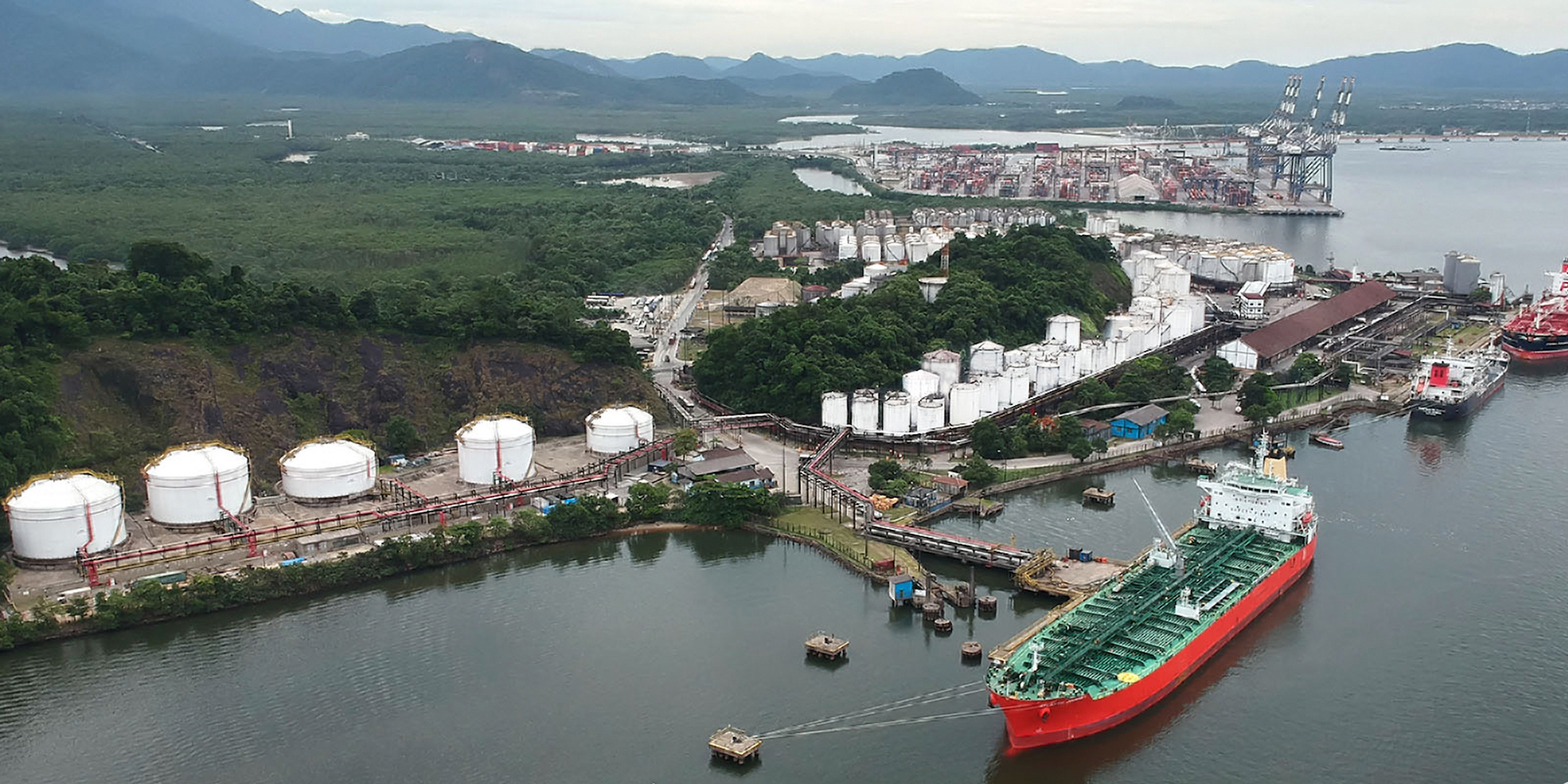
Lean logistics for better customer service
CASE STUDY – Logistics can be the key to achieving success and creating a competitive advantage in a company. This case study tells the story of a port terminal in Brazil that has used lean to achieve significant gains in managing its road flow.
Words: Alexandre Cardoso, lean coach at Lean Institute Brasil, and Cauim Lopes, Logistics Manager, AGEO Terminals
Ageo is a large port terminal for chemicals and fuel storage, located on an island off the city of Santos, Brazil. It began operations in 2004 (currently, these take place in two terminals – AGEO North, which specializes in fuel, and AGEO South, which specializes in fuel and chemicals) and, since then, the use of modern technology has been the differentiator that has driven its growth. More recently, in 2016, the company embarked on a lean transformation.
The organization realized it would need to act to reduce customer service time, as its goal of serving customers in two and a half hours or less was rarely achieved. Every day, a lot of time was wasted in operations: there was waiting for the drivers to register at the gates, delays in loading fuel or chemicals on trucks, and manual controls at each step in the process. This had a big impact on the customers, because the performance of the terminals directly affects the logistics of moving their products. Delays were unacceptable, and Ageo knew it needed to get rid of them. To do that, however, it would need to radically change its way of working.
Faced with this challenge, top management decided they would embrace lean thinking to transform the way they managed the business and achieved company objectives (they already knew of the lean philosophy and had already had positive experiences with it in the past). That’s when a successful partnership between Ageo and the Lean Institute Brasil was born.
Initially, the focus of the work should be on the road flow, because the company acknowledged the problems it had in this step of the process. The goal was to reduce the loading and unloading times of the trucks, to respond faster to the customer, and to reduce lines and waiting time for the truck drivers. It would not be a simple task, for Ageo receives an average of 320 trucks each day.
THE PLANNING PROCESS
The improvement work began in November 2016 with the creation of a cross-functional team – consisting of people from operations, commercial, logistics, and administrative departments. This team would have to ensure the project flew successfully.
Their first task was drawing an end-to-end value stream map for the logistics process, from customer request to loading. Drawing a complete value stream map is harder than it seems at first, because it requires that the team to engage with and learn about all the activities that take place in the company and talk to those who do the work on a daily basis. The goal is to accurately represent everything that happens within that value stream.
To avoid the VSM just being a representation of what the team thinks is happening, it is necessary to visit the gemba to verify the formulated hypotheses. The Ageo team spent three days at the gemba to draw the current value stream of the logistics process (you may need even more time depending on your situation).
The team knew that there was a lot of waiting in the process, from the arrival of the truck driver on the island to his departure, and that this was causing customer dissatisfaction due to the high service times. To understand why this happened, the team looked to identify problems at each step in the process. The map revealed that the biggest ones occurred during the driver's registration, when he had to wait for the truck to be weighed on the scale and for the transportation document to be issued.
It's amazing what you can learn by just observing and recording the company's activities at the gemba. Problems that are obvious to those who do the work every day may not be so obvious to those who are making the decisions. That’s why the current state map is an excellent tool to truly understand the work and where the problems are. However, it is not very valuable unless it is accompanied by the drawing of a future state map, which clearly expresses where you want to go and how you will get there.
After some coaching on lean concepts, the team drew the future state map, specifying its goal of reducing driver service time in clearly set, objective numbers. This allowed the team to know where it wanted to go and what it wanted the processes to look like. It was still necessary, however, to decide what to do to reach this state.
To decide which actions to take, the team made an analysis to find out the root causes of the problems. They used the A3 executive report to create effective countermeasures and design a plan of action. After consolidating all the information they had obtained, the team, along with the directors and the company’s President, signed the A3 report. At that moment, they already knew what they needed to do and were ready to get their hands dirty.
THE IMPLEMENTATION
With the A3 report in their hands, the team began to implement their action plan. Some of the key actions they implemented were:
- Introducing a pre-gate – One of the reasons that made the trucks wait was that some of them arrived with no prior scheduling. The pre-gate would be used to check the scheduling in advance and only allow entry to the island to those who were scheduled, thus avoiding too many trucks clogging the operation as they waited to be served. The pre-gate has already been introduced in other terminals on the island because it is considered a good practice created by Ageo.
- Implementation of visual management – Another major problem that Ageo faced was the delay in measuring the weight of the trucks. One of the factors that contributed to the delay was excessive movement, a result of the truck drivers often not understanding which gate led to the scale. To solve this issue, the team created a visual color-coded system to make it easier to identify where to go.

- Reduction of the scheduling window – Prior to the lean implementation, Ageo was quite flexible with the time slots for service: it accepted two-hour delays, but also one-hour advance service. With the new method, only hour of advance or delay is tolerated. Another action taken by the company in that respect included the involvement of customers in the planning process to reduce the number of “no shows”.
- Daily management implementation – Ageo also had major problems in communicating with other areas within the company, which often ended up impairing the decision-making process. To tackle this issue, the team implemented a daily management system, which encourages and enables effective communication between people from different areas. It allows everyone to track daily operations and logistics performance, resulting in actions being taken more quickly. Ageo employees are increasingly interested in this tool and are using it more and more.

- Registration process centrally located and close to the parking lot – One of the biggest forms of waste that Ageo experienced was excessive movement. The trucks had to cover long distances to go from one step of the process to the next. Registration, for instance, was far from the parking lot, almost a mile away, which created additional waiting. The team decided to move the registration spot to a location closer to the parking lot, reducing the distance by more than 80%, which saved up to 20 minutes.
- Standardized work on the loading and unloading platform – Operator errors was also an issue to tackle. The implementation of standardized work on the platform meant that the company achieved productivity and safety gains, preventing the operator from performing operations in the wrong way.

RESULTS AND NEXT STEPS
Ageo has already achieved significant results thanks to lean thinking. Some can be measured quantitatively: a 75% reduction in average service time; 50% and 33% reduction in loading and unloading times respectively; a 79% reduction in overtime; and a 90% reduction in the time needed for validation (due to the fact that this activity went from being performed manually, using a printed list, to digitally, with a tablet, which also guarantees a real-time updating of the information).
Other results are harder to measure, but still visible in the daily work. For instance, the registration step is now more aligned to daily demand, and there was a significant reduction in rework. Employees also enjoy better ergonomics, customer satisfaction has increased, and time waste has dropped.
Ageo has already come a long way, but it does not want to stop there. The company is now preparing to launch the second phase of its lean transformation, cascading its successful practices to other levels of the organization. Its goals now include scheduling linearization, reducing the no-show rate, implementing an S&OP, and applying with equal success all the concepts they have learned to the maritime process. We will keep you informed on the developments.
Translated from Lean Institute Brasil
Originally published in Mundo Logística (Brazilian Logistics Magazine)
THE AUTHORS


Read more


INTERVIEW - Håkan Borglund, CIO of Toyota Material Handling Europe, speaks with Planet Lean about Toyota principles and the role of lean IT at Toyota Material Handling.


NOTES FROM THE GEMBA – The author visits a private engineering school to learn about their approach to teach Lean Thinking and apply it to their own work.


FEATURE ARTICLE – By adopting lean thinking and establishing a dedicated care pathway, a Brazilian hospital has been able to drastically reduce the time breast cancer patients have to wait to undergo surgery or start treatment.


FEATURE – What if we ran our production schedule to time instead of quantity? While creating overproduction, running to time is a temporary first step to establish levelled production with fixed repetitive cycles.

